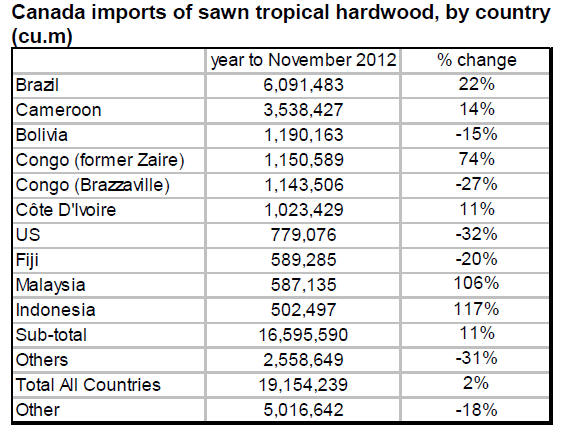|
Report
from
North America
Tropical sawn hardwood imports
The US tropical hardwood market continued to recover in 2012, and
year-to-date imports of tropical sawn hardwood were up 10% in November
compared to 2011. November imports were 18,554 cu.m. in November, down
22% from October.
Imports of Ipe showed the strongest recovery ,with November year-to-date
imports more than twice that of 2011 volumes. Jatoba and sapele imports
also grew, while imports of cedro and meranti declined from the previous
year.
Ecuador remains the largest supplier of tropical sawn hardwood with
balsa accounting for all shipments to the US in November 2012 (3,609
cu.m.). Brazilí»s ipe exports declined to 1,185 cu.m. in November after
reaching over 4,000 cu.m. last summer.
Camerooní»s sawn sapele shipments remained relatively strong at 1,748
cu.m. in November.
Malaysiaí»s exports of sawnwood to the US increased in November mainly
because of higher keruing sawnwood shipments (1,855 cu.m.).
The Hardwood Review reports good demand for African mahogany, sapele and
cedro from South America.


Canadian imports of tropical sawnwood declined to US$1.2 million in
November, the lowest level since January 2012. Year-to-date imports
remain 2% above 2011.
Quebecí»s hardwood flooring manufacturers are the key users of sawn
tropical hardwood in Canada. With the US housing market rebounding,
Canadian imports of tropical hardwoods are expected to grow at a faster
pace.

US manufacturing expanding, led by furniture
The US manufacturing sector expanded towards the end of 2012 according
to the latest survey by the Institute for Supply Management.
The manufacture of furniture and related products was the
fastest-growing sector of the US economy in December.
The US Census Bureau reports a 4.6% growth in new orders for December
compared with the previous month, while shipments increased by 1.3%.
New tax on sawnwood and engineered wood products
California has introduced a 1% tax on the retail price of sawnwood and
engineered wood products sold in the state. The new tax came into effect
January 2013 and is expected to raise US$30 million annually.
The money will be used for regulatory supervision of forest harvesting
in California, thereby shifting the cost burden from the timber industry
to consumers.
The new tax is assessed on so-called primary wood products with a wood
content of at least 10%, but not on products assembled or processed from
primary wood products.
All grades of sawnwood are taxed, also decking, railings and plywood.
The following products are not taxed: furniture, moulding, millwork and
hardwood flooring. The full list of products is available at::
http://www.boe.ca.gov/industry/lumber_products.html
í«Build Americaní» initiative launched
A í«Build Americaní» initiative was launched in January, modeled on Buy
American efforts targeted at consumers. The initiative is supported by
more than 180 building material manufacturers, suppliers and home
builders from across the US.
On average a US home contains an estimated 65% of US-made materials (by
value). The goal of the initiative is to increase this share both in new
house construction and in repair and renovation of existing homes.
íí
|